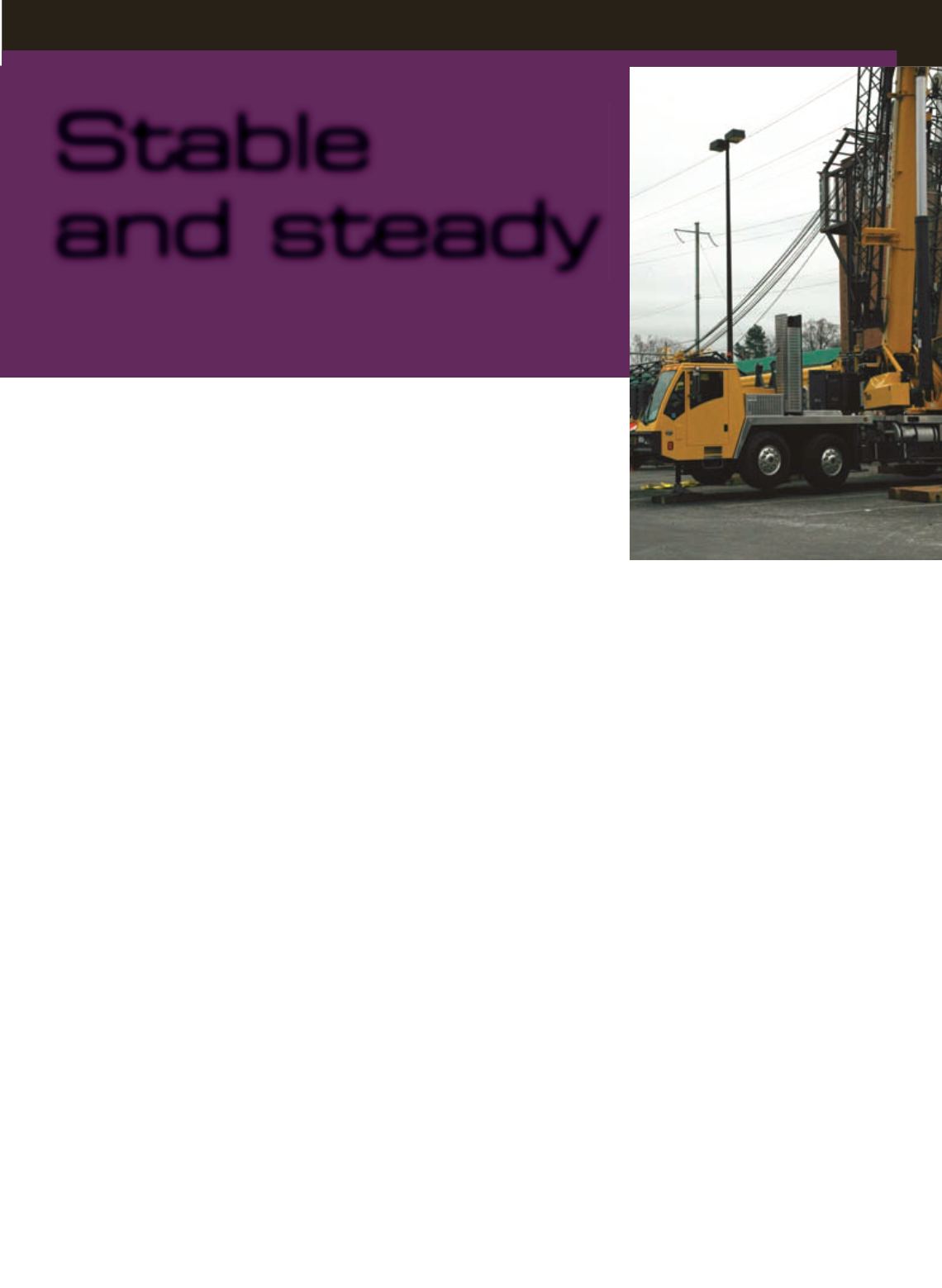
41
MOBILE CRANE STABILIZATION
SPECIAL REPORT
SEPTEMBER 2013
ACT
David Duerr
discusses what needs to be done to
assure safe support for a mobile crane.
A second point to remember is that the
support loads that occur during the lift
may not be the maximum loads. In some
cases, the greatest loads under the crane
occur when swinging with no load on
the hook. This condition must also be
checked.
Some crawler cranes have track pads
that are tapered up on either side and end
tumblers that are an inch or so higher
than the track rollers. Consequently, the
ground-bearing calculations for these
cranes distinguish between a soft surface,
where the tracks will bear on their full
width and from tumbler to tumbler, and
a hard surface, where the tracks will
bear only on the flat center surface of
the pads and only along the length of
the rollers. If the crane is to be set up on
mats, the track bearing pressures must
be determined based on the hard surface
condition.
Ground strength
The second side of the support equation
is that of ground bearing capacity. How
strong is the ground? This can be a very
difficult question to answer because
of the many factors at work. The large
loads from a mobile crane on the surface
create pressure in the soil many, perhaps
dozens, of feet down. This means that the
apparent strength due to a hard surface
layer can be diminished by a soft layer
a few feet below the surface. Further,
underground structures, such as pipes,
culverts, buried tanks and the like, can
be the weak link in the support capacity
chain.
There are other site features that affect
ground capacity that are easily observed.
The bearing capacity near a slope may
be less than that elsewhere on the site. A
large load too close to a slope can cause
an abrupt soil failure. A retaining wall
is also a red flag. Loads on the surface
create horizontal pressure against the
wall that can cause overturing or a
structural failure. And if the wall is new
construction, how well has the backfilled
soil next to the wall been compacted?
When planning a major lift in a safety-
critical location, such as in a refinery, it is
common practice to have a geotechnical
engineer take soil borings and prepare
a detailed report that shows the ground
bearing capacity at the surface. For
smaller jobs, however, this is often not
practical. Here, the ground bearing
capacity must often be assumed based
on past experience at the site or by
simply working with a very low allowable
bearing pressure. However, when making
assumptions about ground bearing
capacity, never lose sight of the fact
that without adequate support, nothing
else matters. This is not the place to cut
corners.
When crane mats are
needed
Soil conditions in many locales are such
that all except the smallest cranes will
require some type of load spreading
materials to reduce the pressures imposed
by the crane to values low enough that
T
he load ratings of a mobile
crane are based in part on the
requirement that the crane
be set up on a firm and level surface.
The crane must be level when initially
assembled and it must remain level
within the tolerance specified by the
manufacturer during all operations. It
is the collective responsibility of the site
supervisor, the lift director and the crane
operator to assure that ground conditions
at the site are known, the loads that
the crane will impart to the ground are
known, and that any mats, pads or other
structural elements needed to safely
support the crane are correctly used.
So how do we go about accomplishing
these tasks? This article looks at the
primary activites that must be performed
to assure safe support for a mobile crane.
Two sides of equation
There are two questions that must be
answered to start the evaluation of crane
support: What loads are imposed on the
ground by the crane? How strong is the
ground?
Answering the first question is
often easy. Many of the major crane
manufacturers have produced computer
programs, either stand-alone or web-
based, that a lift planner can use to
calculate the outrigger loads or crawler
track bearing pressures for a given
lift. Key to the successful use of these
programs is assuring that all information
entered into the program is accurate. We
all immediately think of load and radius,
but many other input values are often
required. These include boom type and
length, extension mode for telescopic
hydraulic booms, boom tip extensions
or jibs, counterweight size, crawler pad
size and outrigger extension position.
Carelessness in defining the crane here
can produce inaccurate results.
Stable
and steady
Generally, all but the the smallest cranes
will require some type of load spreading
materials to reduce the pressures imposed
by the crane to values low enough that they
can be safely supported by the ground. This
means that crane mats are needed.


